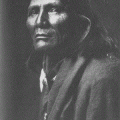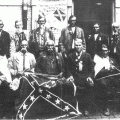
This is the first in a three-part series on the Dark Ages of American Indian Religious Freedom.
For the past five centuries, American Indians have had their religions suppressed (sometimes brutally and violently) and denied. With the formation of the United States and the adoption of the Bill of Rights which speaks of freedom of religion, this freedom has been denied to American Indians based on the notion that they were not citizens and therefore this freedom did not apply to them. The period of time from 1870 to 1934 can be considered the Dark Ages for American Indian Religious Freedom. During this time, the active suppression of American Indian religions reached its peak.
In this first part, we are going to look the faith-based administration of Indian reservations which sometimes resulted in theocracies.
In 1870, President Ulysses S. Grant faced a major problem: the Indian Service (now the Bureau of Indian Affairs) was notoriously corrupt. The solution to this problem appeared obvious: to turn over the administration of the reservations to Christian (preferably Protestant) church groups. In his 1870 message to Congress, President Ulysses Grant explained that he had “determined to give all the agencies to such religious denominations as had heretofore established missionaries among the Indians, and perhaps to some other denominations who would undertake the work on the same terms – i.e. as missionary work.” This became the policy known as the Peace Policy.
Under the policy, a single Christian denomination would become responsible for administering all Indian programs on each reservation and would have a monopoly on proselytization. Under American policy at this time, the efforts to “civilize” the Indians required them to become Christian. Therefore conversion, by force if necessary, was an important part of American policy.
There was no concern at this time for either the existence or validity of any Indian religions. In fact, Indian religious leaders were seen as barriers to progress and could be jailed for expressing their religious concerns.
In accordance with President Ulysses Grant’s Peace Policy, the Secretary of the Interior allocated 80 reservations among 13 Christian denominations. The anti-Catholic sentiment of the time is clearly evident in the allocation of the Indian agencies among the various Christian denominations. By the terms stated in Grant’s policy, namely that missions should be allocated among the missionaries already at work there, Catholic officials expected to receive thirty-eight missions; instead they were accorded only eight, all of them in either the Rio Grande valley or the Pacific Northwest. Subsequently, Catholic missionaries began to be ordered off certain reservations.
In response to the anti-Catholic actions of the government, the Bureau of Catholic Indian Missions was created in 1874 to protect and advance the missionary work which was threatened by President Grant’s Peace Policy.
One of the examples of this faith-based administration of an Indian reservation can be seen in Idaho where the Nez Perce Reservation became a model theocracy and helped contribute to the 1877 Nez Perce War.
While the Nez Perce Reservation was originally assigned to the Catholics, the Presbyterians protested and acquired the reservation. Under this administration, the traditional Nez Perce ways were not only frowned upon, but they were openly ridiculed and prohibited. In the schools, the teachers (who were often missionaries) deliberately made the Indians ashamed of their own traditions, history, culture, and lore. New regulations prohibited plural marriage, gambling, shamanism, and traditional drumming, singing, dancing, and ceremonial clothing. The new Indian agent also condemned long hair on men.
Under the new Peace Policy, each reservation was to be a monopoly. In the case of the Nez Perce Reservation, the new Indian agent ordered the Methodist missionary off the reservation and refused to allow the Catholics to build a mission.
Not only was the faith-based administration of the Indian reservations biased against the Catholics, it also actively opposed missionaries from the Church of Jesus Christ of Latter Day Saints (commonly called the Mormons). In 1875, for example, government officials not only barred Mormon missionaries from the Fort Hall Indian Reservation in Idaho, they also sent out troops to break up Mormon gatherings and bring the Indians back to the reservation.
When the Mormons established an off-reservation farm for the Shoshone, there were demands that the Indians be returned, by force of arms if necessary, to the Fort Hall Reservation. While the Indian agent reported that the Indians at the farm had never resided on the reservation, it was still felt that they should be moved to the reservation and away from the influences of the Mormons.




Leave a Reply